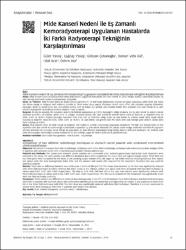| dc.contributor.author | Yavaş, Güler | |
| dc.contributor.author | Çobanoğlu, Gökçen | |
| dc.contributor.author | Gül, Osman Vefa | |
| dc.contributor.author | Yavaş, Çağdaş | |
| dc.contributor.author | Acar, Halil | |
| dc.contributor.author | Ata, Halil | |
| dc.date.accessioned | 08.07.201910:49:13 | |
| dc.date.accessioned | 2019-07-08T20:19:06Z | |
| dc.date.available | 08.07.201910:49:13 | |
| dc.date.available | 2019-07-08T20:19:06Z | |
| dc.date.issued | 2014 | en_US |
| dc.identifier.citation | Yavaş, G., Çobanoğlu, G., Gül, O. V., Yavaş, Ç., Acar, H. ve Ata, H. (2014). Mide kanseri nedeni ile eş zamanlı kemoradyoterapi uygulanan hastalarda iki farklı radyoterapi tekniğinin karşılaştırılması. Bakırköy Tıp Dergisi, 10(1), 11-17. | en_US |
| dc.identifier.issn | 1305-9319 | |
| dc.identifier.uri | https://hdl.handle.net/20.500.12511/611 | |
| dc.description.abstract | Amaç: Mide kanseri tanısı ile postoperatif kemo-radyoterapi uygulanan hastalarda dört alan teknik ile sanal wedge (kama) kullanılarak yapılan üç alan tekniği dozimetrik açıdan karşılaştırmayı amaçladık. Gereç ve Yöntem: Mide kanseri tanısı ile total/subtotal gastrektomi ve lenf nodu diseksiyonu yapılan on hasta çalışmaya dahil edildi. Her hasta için tümör yatağı ve bölgesel lenf nodlarına yönelik iki farklı tedavi planı yapıldı. Planlanan hedef hacim (PTV), risk altındaki organlar (böbrekler, karaciğer, dalak ve spinal kord), doz homojenite indeksi (DHI) ve tedavi için gerekli olan monitör ünitler (MU) açısından dört alan teknik ile üç alan teknik karşılaştırıldı. İstatistiksel analizde student t test kullanıldı. Bulgular: İki teknik arasında DHI açısından anlamlı bir farklılık saptanmadı (p: 0.576). Karaciğerin aldığı ortalama doz üç alan teknik ile anlamlı olarak azalırken (p<0.001); sol böbrek, spinal kord ve dalağın ortalama dozları dört alan teknik ile anlamlı olarak daha az bulundu (p değerleri sırası ile 0.007, 0.021 ve <0.001). Toplam karaciğer hacminin %10, %30, %40 ve %50’sinin aldığı dozlar üç alan teknik ile anlamlı olarak daha düşük olarak bulundu (p değerleri sırası ile 0.026, 0.009, 0.001 ve <0.001). Üç alan teknik için gerekli olan MU sayısı dört alan tekniğe göre anlamlı olarak daha fazla bulundu (p<0.001). Sonuç: Mide kanseri tanısı ile mide yatağı ve bölgesel lenf nodlarına yönelik radyoterapi uygulanan hastalarda PTV’deki doz homojenitesi ve DHI açısından dört alan teknik ile sanal wedge kullanılarak oluşturulan üç alan teknik arasında fark yoktur. Sanal wedge kullanılan teknikte MU sayısının artması beklenen bir sonuçtur. Sanal wedge ile uygulanan üç alan teknikte karaciğerin aldığı dozlar anlamlı derecede azalmıştır. Bu nedenle eşlik eden bir karaciğer rahatsızlığı bulunan hastalarda üç alan tekniği uygun bir tedavi şekli olarak görülmektedir. | en_US |
| dc.description.abstract | Objective: We aimed to compare four field radiotherapy techniques with three field radiotherapy technique with enhanced dynamic wedges (EDW) in patients with stomach cancer who underwent postoperative chemo-radiotherapy. Material and Methods: Ten consecutive stomach cancer patients who underwent total/ subtotal gastrectomy and lymph node dissection were included to the study. For each patient, two different treatment plans were created for the tumor bed and regional lymph nodes. Three field and four field plans were compared for the doses in the planning target volume (PTV), the organ at risk (OAR) volumes (including kidneys, liver, spleen and spinal cord), the dose homogeneity index (DHI), and the monitor unit counts (MU) required for the treatment. Student-t test was used for statistical analysis. Results: There was no difference between two techniques in terms of DHI (p:0.576). The mean dose received by the liver was significantly reduced with three field technique (p<0.001); whereas the mean doses of the kidneys, spleen and spinal cord were decreased with four field technique (p values were 0.007, 0.021 and <0.001 respectively). The dose to %10, %30, %40 and %50 of the total liver volume were significantly reduced with three field technique (p values were 0.026, 0.009, 0.001 and <0.001 respectively). The MU counts required for the treatment was significantly lower with four filed technique (p<0.001). Conclusion: There weren’t any difference in terms of dose homogeneity in the PTV and DHI between four field technique and three field techniques with EDW in patients with stomach cancer who underwent radiotherapy to the tumor bed and regional lymph nodes. It was expected to need more MU in the three field technique with EDW. The liver dose was significantly reduced with three field technique. Therefore it is more convenient to choose three field techniques with EDW in patients with known liver disease | en_US |
| dc.language.iso | tur | en_US |
| dc.rights | info:eu-repo/semantics/openAccess | en_US |
| dc.subject | Doz-Volüm Histogramları | en_US |
| dc.subject | Mide Kanseri | en_US |
| dc.subject | Radyoterapi | en_US |
| dc.subject | Dose Volume Histograms | en_US |
| dc.subject | Stomach Cancer | en_US |
| dc.subject | Radiotherapy | en_US |
| dc.title | Mide kanseri nedeni ile eş zamanlı kemoradyoterapi uygulanan hastalarda iki farklı radyoterapi tekniğinin karşılaştırılması | en_US |
| dc.title.alternative | Comparison of two different radiotherapy techniques in stomach cancer paıients who underwent concomitant chemoradiotherapy | en_US |
| dc.type | article | en_US |
| dc.relation.ispartof | Bakırköy Tıp Dergisi | en_US |
| dc.department | İstanbul Medipol Üniversitesi, Tıp Fakültesi, Dahili Tıp Bilimleri Bölümü, Radyasyon Onkolojisi Ana Bilim Dalı | en_US |
| dc.identifier.volume | 10 | en_US |
| dc.identifier.issue | 1 | en_US |
| dc.identifier.startpage | 11 | en_US |
| dc.identifier.endpage | 17 | en_US |
| dc.relation.publicationcategory | Makale - Uluslararası Hakemli Dergi - Kurum Öğretim Elemanı | en_US |
| dc.identifier.doi | 10.5350/BTDMJB201410103 | en_US |
| dc.identifier.scopusquality | Q4 | en_US |


















